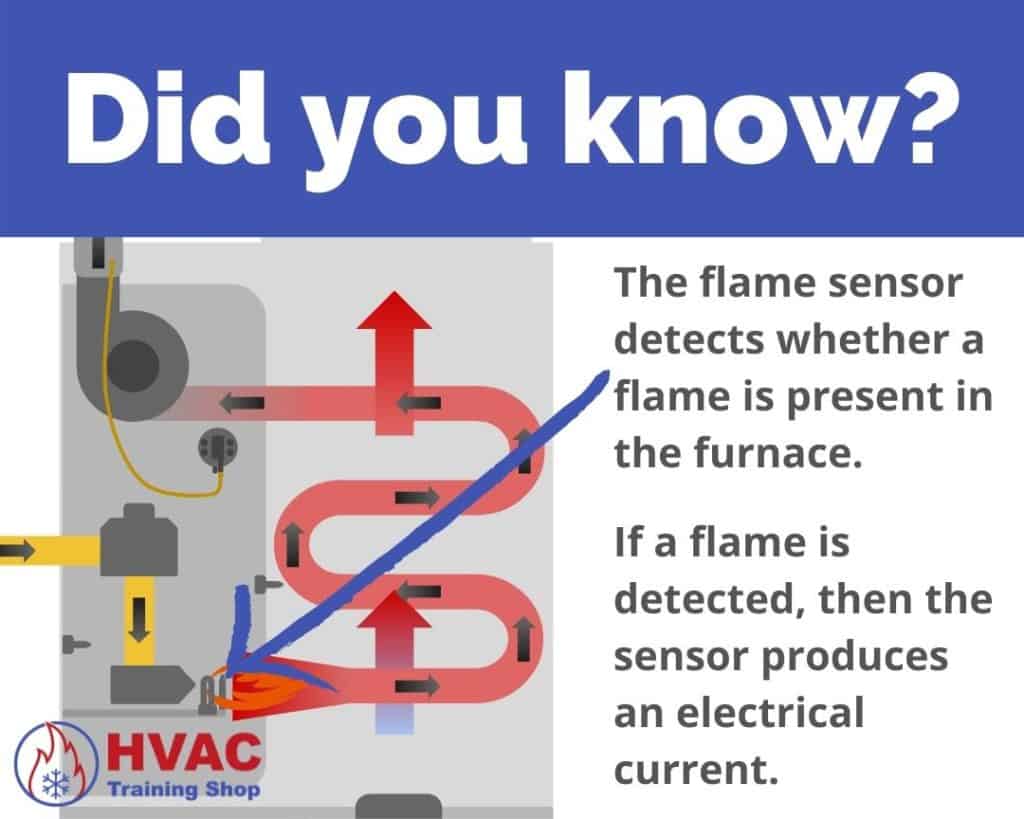HVAC Training Shop is reader-supported. As an Amazon Associate, I earn from qualifying purchases.
Is your furnace not heating your home? The most common reason is the flame sensor.
The flame sensor in a furnace is an important safety device that detects if a flame is being produced. Its function is critical– if the flame sensor is not working properly, then the furnace won’t produce any heat.
In this article, I’ll go over the most important things that you need to know about your furnace’s flame sensor.
First, I’ll show you where to find the flame sensor.
Next, I’ll discuss how to clean a flame sensor.
I’ll also go over how a flame sensor works, and how to test and replace a flame sensor.
Where is the furnace’s flame sensor?
The furnace’s flame sensor is located in front of the burners. It is a rod that sticks out where the flame comes out of the burner.
The flame sensor is always on the opposite side of the ignitor. For example, if the ignitor is on the right side of the burners, then the flame sensor is on the left side.

How to clean your furnace’s flame sensor
If your furnace is firing up, but not staying on, then the first thing that you should do is clean the flame sensor.
In fact, a dirty flame sensor is one of the most, if not THE most common problem in a furnace.
To clean the flame sensor, follow these steps:
- Make sure that your furnace has been off for at least 30 minutes so that its internal parts are cool. You don’t want to clean a hot flame sensor.
- Turn off the power to your furnace and open the access panel to the burners.
- Find the flame sensor. Somewhere in front of the burners is the flame sensor. The flame sensor is usually a short rod that sticks out in front of where the flame would be.
- Remove the flame sensor. You may need a small screwdriver or nut driver to remove the flame sensor. The flame sensor is also connected to the control board by a single wire. You can disconnect this wire if you need to, just remember to put it back.
- Clean the flame sensor I prefer using a scouring pad. If you don’t have one, then a dollar bill works fine. Scrub the flame sensor until the black charred layer is removed. The sensor should have a dull shine.
- Place the flame sensor back into its spot and re-fasten it down. Re-connect the flame sensor wire if you took it off earlier. Close up the furnace and turn its power back on before trying to run it again.
One important note– you shouldn’t use sandpaper or steel wool to clean your flame sensor. Unless the sandpaper is fine grit.
Using rough abrasives will scratch the sensor rod too much. It will only cause the sensor to get dirty faster next time.
These scouring pads are perfect for cleaning flame sensor rods. They are abrasive enough to remove char, but not too abrasive– so they won’t leave deep scratches.
What does a flame sensor do in a furnace?
The furnace’s flame sensor is a safety device—its purpose is to prevent unburned gas from spilling into your home.
How does it do that? The flame sensor detects if your furnace is actually burning its gas and producing a flame.
The flame sensor is a rod that sticks out in front of the furnace’s burners.
When the burners are producing a flame, the flame sensor detects that and tells your furnace’s control board that a flame is detected. The control board receives this signal and knows that everything is okay.
When no flame is detected, the flame sensor does not send a signal to the control board.
If the control board doesn’t receive a signal from the flame sensor within a few seconds of opening the gas valve, then the control board knows that something is wrong. The control board will then shut down the furnace to prevent unburned gas from leaking out of your furnace.
This is why a dirty flame sensor will cause problems in your furnace. A dirty flame sensor won’t properly detect a flame. Next thing you know your furnace is shutting off even though everything is working just fine.
How to test a flame sensor
If you need to check if your flame sensor is working properly, then you can test it using a multimeter.
However, not all multimeters are capable of testing a flame sensor.
Your multimeter will need to be able to read DC microamps (μA) in order to test a flame sensor.
To test a flame sensor, follow these steps:
- Turn off the power to your furnace and open the access panel to the burners.
- Find the flame sensor. Somewhere in front of the burners is the flame sensor. The flame sensor is usually a short rod that sticks out in front of where the flame would be.
- Remove the flame sensor wire. The flame sensor is connected to the control board by a single wire. Disconnect this wire.
- Connect your multimeter in series with the flame sensor and its wire. Connect the positive (red) multimeter lead to the flame sensor’s terminal. Connect the negative (black) multimeter lead to the flame sensor wire that goes to the control board. Ensure that your multimeter’s wires are clear of the burners so they don’t get roasted when the furnace turns on.
- Turn on your multimeter. Switch your multimeter to the DC microamps mode.
- Turn on your furnace. Use your thermostat to call for heat.
- Wait until the furnace turns on and the burners fire up. After a flame is produced, the flame sensor should read current somewhere in the range of 2 to 6 microamps. If your flame sensor does not produce a current in the presence of a flame then the flame sensor is bad.
How to replace a furnace flame sensor
Flame sensors can go bad for a few different reasons:
- Cracked ceramic insulator– causes the flame sensor to short out
- Broken sensing element
- Degradation over time– causes the flame sensor to not produce enough current
If your furnace’s flame sensor is bad, then it will need to be replaced.
To replace a furnace flame sensor, follow these steps:
- Make sure that your furnace has been off for at least 30 minutes so that its internal parts are cool. You don’t want to touch a hot flame sensor.
- Turn off the power to your furnace and open the access panel to the burners.
- Find the flame sensor. Somewhere in front of the burners is the flame sensor. The flame sensor is usually a short rod that sticks out in front of where the flame would be.
- Remove the flame sensor. The flame sensor is connected to the control board by a single wire. Disconnect this wire. You will need a small screwdriver or nut driver to remove the flame sensor from the furnace.
- Install the new flame sensor. Put the new flame sensor in the same location as the old one. Fasten the new sensor down using the same screw/nut that you removed from the old one.
- Connect the wire to the new flame sensor. If your new flame sensor has a different type of connector, you will need to use that type of connector.






Hello
The failure of flame sensing happens when the flame current is less than designed or the detection circuit on PCB is damaged. The flame current is determined by the resistance of the flame itself, which is a given constant, plus the resistance of the two poles exposed to the flame: the flame sensor and the burner’s front area. In my case, after multiple tries of various successes, cleaning the flame detector became ineffective. I was ready to replace the furnace but I gave a try in cleaning the corresponding burner. Its surface felt rough. After cleaning and resetting it all worked just fine with the sensor previously considered as ineffective.